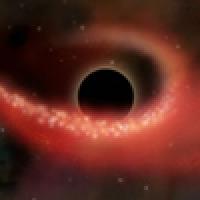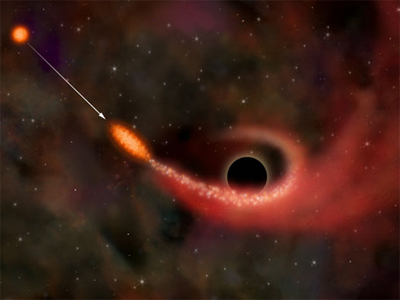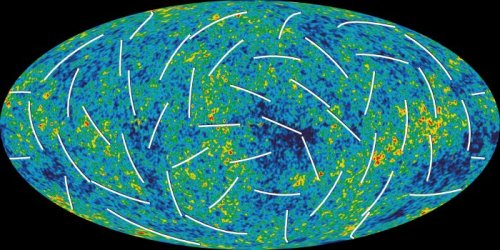
Black holes: Paradox regained
This article first appeared on the FQXi community website. FQXi are our partners in our Information about information project. Click here to read other articles on information and black holes.
Most kids are fascinated by stories of black holes that swallow and crush everything unfortunate enough to fall into their clutches. Even physics itself gives up in the face of such ferocity, the story goes: the laws we use to describe the rest of spacetime no longer apply inside black holes. Basically, "nothing makes sense at the centre of a black hole," says Steve Giddings, a physicist at the University of California, Santa Barbara (UCSB)
Growing up in Salt Lake City, Utah, Giddings was not only bewitched by black holes, he was also one of those rare teenagers who questioned the logic of the standard explanations. "That doesn't make sense that nothing makes sense," he recalls thinking to himself. "There's got to be some answer."

Steve Giddings. University of California, Santa Barbara.
More than two decades later, Giddings, is still intrigued by black holes. In the intervening years, there have been a number of plot twists in their tale, mostly surrounding the debate over whether black holes also destroy information as they munch on matter, violating the laws of quantum mechanics that say that information cannot be lost.
The question seemed to be settled in 2004, when Stephen Hawking — the main proponent of the notion that information is lost — famously changed his mind over the issue. While Giddings thinks that Hawking was right to say that information isn't lost in black holes, he notes that we still lack a full explanation of what happens to information. To really understand how information survives, Giddings argues, we have to throw out our familiar conception of space-time.
The black hole information paradox goes back to the mid-1970s, when Hawking and fellow physicist Jacob Bekenstein of the Hebrew University in Jerusalem, Israel, showed that black holes should gradually radiate thermal energy. But this led to a conundrum: Consider two high energy particles that are smashed head on (say, within a particle accelerator, such as the Large Hadron Collider (LHC)) creating a black hole. According to Hawking's original argument, the black hole would give off so-called Hawking radiation, but, because this radiation is thermal, it has missing information. The black hole eventually evaporates and the end result is significant loss of information. The problem is that this violates quantum mechanics, which says that information is sacrosanct and cannot be destroyed.
The trouble does not end there. In 1984, physicists Tom Banks, of the University of California, Santa Cruz, and Leonard Susskind and Michael Peskin, of Stanford University, argued that information loss in the context of black holes would lead to a unreasonably hot Universe. This happens because the vacuum of spacetime is not empty, but rather it is a foaming sea in which virtual particles are forming and disappearing all the time. Quantum mechanics does not prevent the same from happening with virtual, microscopic black holes. If these black holes lose information, the net consequence of this process, Banks, Susskind and Peskin showed, is that the temperature of the vacuum would be a whopping 1.4 x 1032 Kelvin. "Which is ridiculously high," says Giddings, with a touch of understatement.
Paradox Lost?
The black hole information paradox passed into physics folklore, with Hawking famously making a bet with Caltech's John Preskill in 1997 that black holes do obliterate information. But in 2004, Hawking conceded that his prediction had been wrong and that information could, in fact, escape — apparently resolving the paradox and sidestepping Banks, Susskind and Peskin's hot Universe problem. But Hawking never fully explained what was wrong with his original argument.
Prior to Hawking's turnaround, other physicists had also claimed to have solved the information paradox, by considering string theory, which posits that elementary particles are composed of tiny, vibrating strings. The mathematics of string theory allowed them to relate the physics on the surface of an object with its contents (thanks to the so-called AdS/CFT correspondence developed by Juan Maldecena of Princeton University, in 1997), which suggested information could leak out through quantum wobbles of the black hole's event horizon. But not everyone was convinced by these string theory arguments, including Giddings, who argues that the problem is alive and well — and that more explanation is needed.
Giddings is no slouch when it comes to string theory. Carrying his fascination with black holes into grad school at Princeton in 1983, he shopped around for an advisor to help his quest to understand black holes and other thorny problems by turning to string theory — and he aimed high. "Initially I talked to David Gross" (who would go on to win a share of the Nobel Prize in physics in 2004) "but he decided to take on somebody else, so I had to hunt around and ended up with this unknown guy," jokes Giddings. The "unknown guy" was Ed Witten, whose name has since become synonymous with string theory.
Despite learning from one of the discipline's masters, Giddings feels string theory hasn't yet fulfilled its promises. For one, he thinks it hasn't shown conclusively that the black hole information paradox can be solved using the AdS/CFT correspondence. The correspondence essentially links a lower-dimensional theory with a higher dimensional theory. The solution for the black hole information paradox works only if there is a very precise one-to-one correspondence between each and every aspect of the two theories. "But do we really have a precise correspondence, or is there detail lost in going from the higher dimensional theory to the lower dimensional theory?" says Giddings. As far as he is concerned, the answers to these questions haven't been established yet.

Artist's depiction of a supermassive black hole ripping apart and consuming part of a star — an event confirmed by NASA's Chandra and ESA's XMM-Newton X-ray Observations. Image: NASA/CXC/M.Weiss
As a result, he views the claim that string theory provides a way out of the black hole information paradox as premature and incomplete. That means that either Hawking's original view was correct and that information is destroyed in black holes, in which case he must find his own way around Banks, Susskind and Peskin's 1984 prediction that this would lead to a ridiculously hot Universe, or Hawking's original prediction was wrong — but for reasons that go beyond present string theory proposals.
"The big question is where did we go wrong?" asks Giddings. Most physicists re-analysing the arguments made by Banks, Peskin and Susskind feel that they have got the right story, he says. That means Hawking was wrong to think that black holes destroy information — but why? The blame might lie not with Hawking, says Giddings, but with the standard version of quantum field theory that Hawking used in his analysis (you can find out more about quantum field theory here).
Quantum field theory explains how all known particles interact with the fundamental forces (except gravity, that is). The basic concept in question here is the assumed locality of space-time. Simply put, that's the idea that there are distinct points in spacetime, and things that happen at one point in spacetime cannot influence things that happen at another point in spacetime any faster than the speed of light. Since light cannot escape a black hole's gravity, that means that points inside a black hole can never communicate with points outside the black hole. "The very basic notion of locality is at the heart of why things and information in particular can't escape from black holes, and why in the end black holes just destroy the information in the conventional picture," says Giddings.
So, thought Giddings, what if quantum field theory is actually non-local? Physicists have considered this possibility in the past and it turns out the answer cannot be that easy. Simply violating non-locality in quantum theory creates its own paradoxes: if faster-than-light signalling was allowed, you could, for instance, send a message back in time to persuade someone to kill your own grandfather before he met your grandmother — and thus you wouldn't exist to send the signal. "Non-locality in quantum field theory is bad. It can get you in all kinds of trouble," says Giddings. "So, in fact, locality appears robust and well-defined in quantum field theory."
But Giddings has identified a key, and debatable, assumption in those locality arguments: "All of that assumes that there is some pre-existing spacetime that defines what it means for things to travel faster than the speed of light or not." Giddings and his colleague Donald Marolf, also at UCSB, are now using a $60,862 grant from FQXi to investigate physics without invoking such a pre-existing space-time.
Information exchange
One proposal being studied describes black holes and their environments as a network of Hilbert spaces (a Hilbert space for any quantum mechanical system defines all possible states that the system can be in). In the conventional picture of a black hole, locality prevents the Hilbert space of the interior of the black hole from influencing the Hilbert space of the exterior of the black hole. In Giddings' model, however, the Hilbert spaces can exchange information. This allows a black hole to slowly evaporate, but not before it has dumped the information contained within into the environment. The idea is that local quantum field theory can be derived as an approximation of this more fundamental underlying structure, in the same way that non-relativistic Newtonian physics can be derived from relativistic Einsteinian physics.
Giddings' preoccupation with the black hole information paradox has not gone unnoticed by his peers. "Steve is one of the few people who understand the information problem in its full form, and his early work has been very useful in helping people understand the details of Hawking radiation," says Samir Mathur of Ohio State University in Columbus.
There are, however, serious implications of such an approach. "The broad lesson is that spacetime is doomed," says Giddings. There is no underlying spacetime. It only emerges in the absence of the kind of extreme boundary conditions experienced in black holes, or in the early Universe.

An image of the cosmic microwave background taken by WMAP. Credit: NASA/WMAP Science Team.
So, how does one test such a theory? It could potentially be tested at future particle accelerators, more powerful than the LHC. First, microscopic black holes will need to be created in highly energetic particle collisions (something that has not yet been seen at the LHC). But more important is measuring the outcome of such collisions. It's not enough to measure the macro properties such as position and momentum of particles emanating from the micro-black-hole, that look like Hawking radiation. Physicists will have to measure their quantum correlations, to see if information is conserved. "That's pretty futuristic," says Giddings.
In the slightly less long term, evidence might come from cosmological observations. Giddings argues that there are aspects of our Universe's inflationary epoch — the time soon after the big bang during which our Universe expanded exponentially — that are not well understood. For instance, in the accepted model, inflation has stopped in our patch of spacetime, but continues elsewhere in the Universe. This conventional picture of eternal inflation has been derived from a combination of local quantum field theory and general relativity and predicts that when inflation continues indefinitely, it leads to a weird behaviour of spacetime, says Giddings. "There would be enough gravitational waves that, roughly speaking, pile up so that you have pretty violent fluctuations of spacetime at the longest scales," he says. This suggests that the conventional picture of gravity needs to be modified here, as well.
Such large spacetime fluctuations would occur at distances that can't be observed, however, either in the variations in the temperature of the cosmic microwave background, which contains an imprint of primordial fluctuations of spacetime, or by the detection of gravitational waves themselves. But Giddings thinks that a modified quantum gravity theory (which combines general relativity with quantum mechanics) with some non-locality might be used to resolve some of the puzzles of inflation. This might result in small but measurable effects in our observable universe. "The idea is that somehow you look for signals in sufficiently precise cosmological observations," he says. "But we don't have something concrete we can point to yet and say, 'go look at this and you'll find it'. It's still too early."